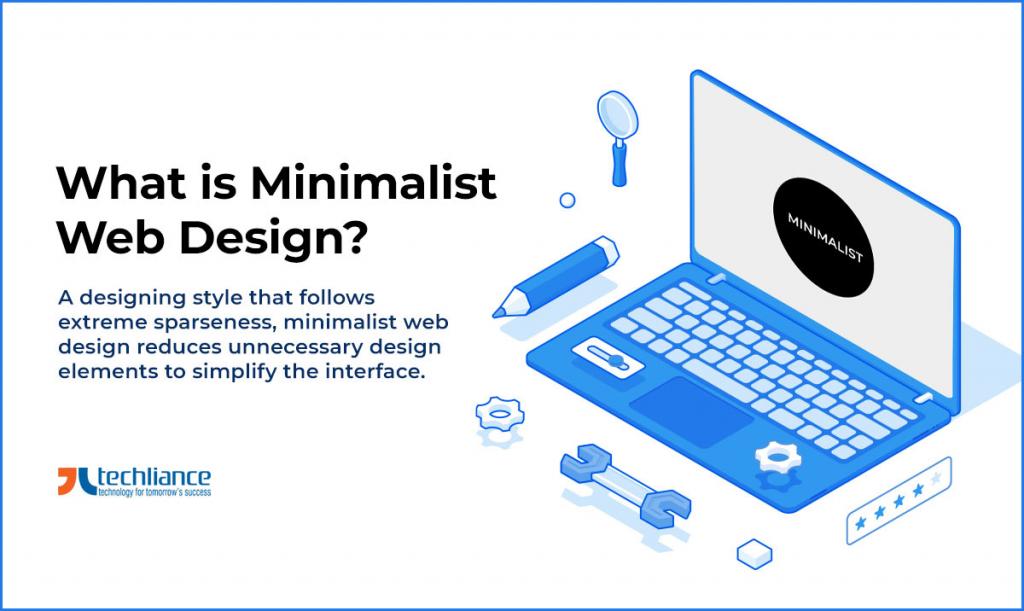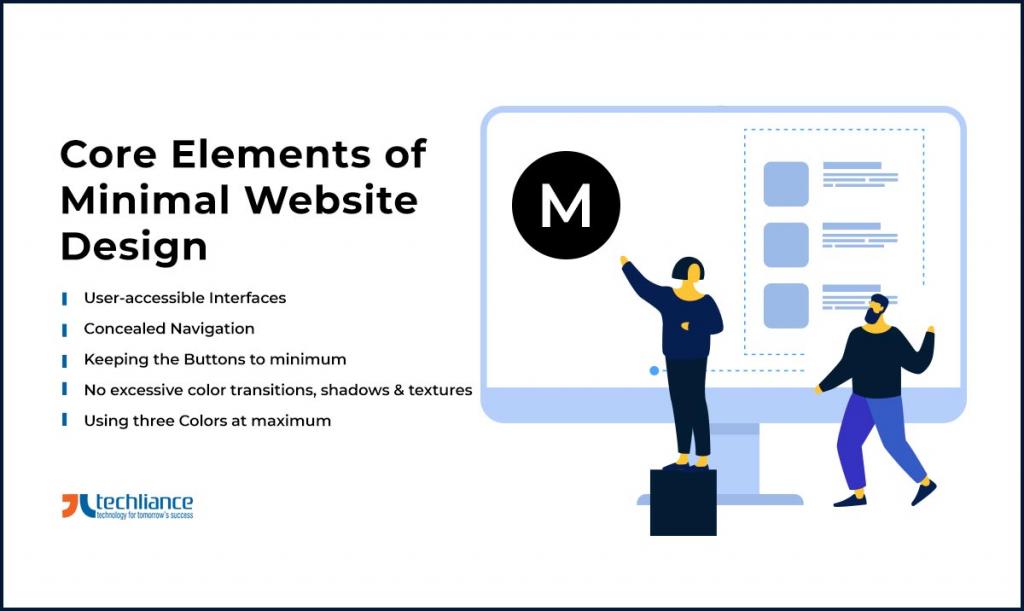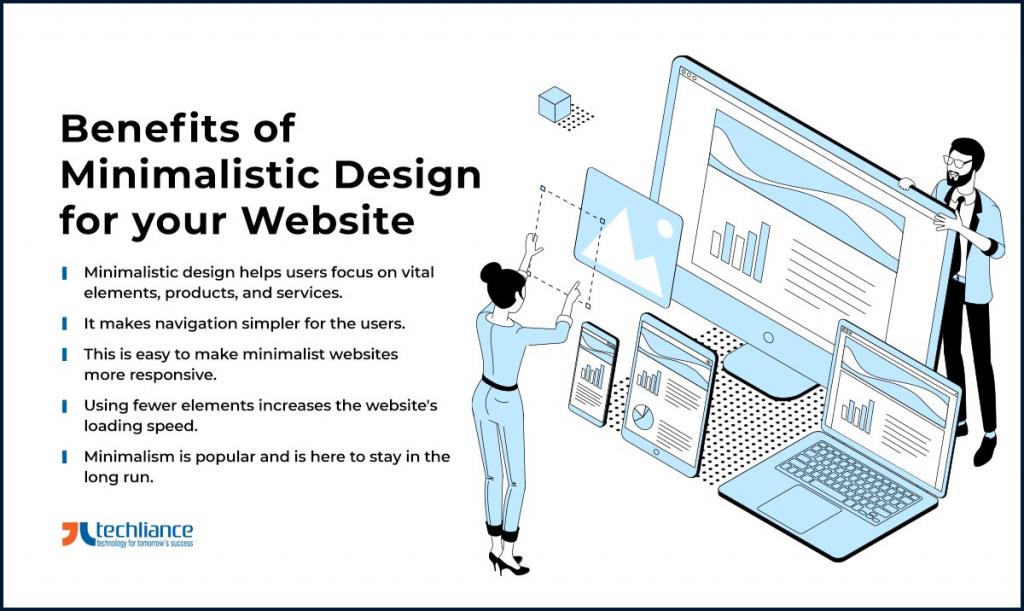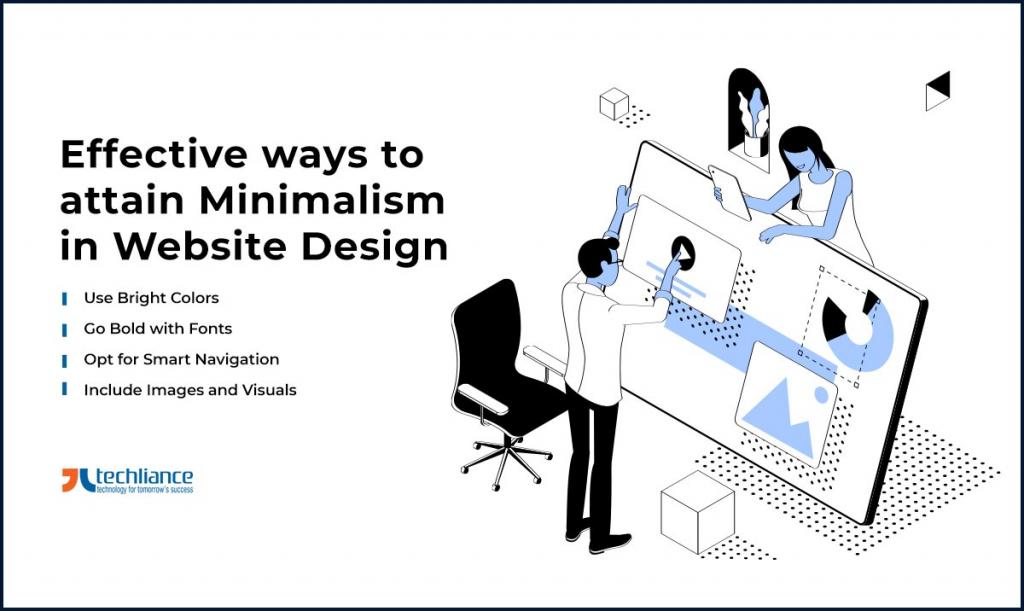As the name suggests, minimalism is the art of opting for less. Although not a new concept, it has got popularized in recent times. The roots of a minimalist web design are found way back in history and are equally popular in modern times.
Like other industry facets, UI/UX and web designers have also got influenced by the minimalism approach while designing the websites. These days, almost all of the internet is filled with minimalist web design. Your website is the first and foremost important representation of your business and what you stand for.
Using a minimalistic approach, you can experiment with colors, transitions, saturations, navigation, and broken components. Also, it allows you to deal with the addition or removal of elements, and much more. Let’s dig deep into the details of a minimalist web design.

Definition of Minimalism and its importance to Design
Minimalism is the process of reducing all elements, and including the ones essential to the design. Technically, minimalism is a designing style or technique that follows extreme sparseness and simplicity. Therefore, it reduces unnecessary design elements to simplify the user interface.
In other words, it is all about being more effective while doing less. Minimalism is often confused with simplicity or using simple design elements. But simplicity doesn’t always translate into minimalism.
Origins of Minimalism and its impact on Modern Age
People consider minimalism is a new trend in the design world. But the basis for minimalist web design has been around much longer. We find the roots of minimalism in Japanese culture, which is prominent with simplicity and balance of colors and structure.
Representing minimalist design elements in architecture, interior design, digital design, and graphic design is evidence of its existence. Minimalism started as a western movement in the early 20th century. It is largely influenced by the Bauhaus movement, which began from the German art school Bauhaus, established by Walter Gropius. This movement made many architects employ minimalist design elements in the architecture of their buildings.
German-American architect Ludwig Mies Van Der Rohe was highly considered among the founders of the minimalist movement. He was the first person to introduce the phrase “Less is more” to architectural designs.
This influenced all other fragments of society. With time, other industries also moved towards implementing minimalism in their designs. Interior designers, industrial designers, digital designers, paintings, and music all opted for a minimalist approach in their respective fields.
Tip: Sources for Website Design inspiration
Role of Minimalism during 2024
Today, the world craves minimalism. You may notice that we are surrounded by minimalism in almost everything around us. Whether it’s the buildings, art, music, products we consume, or other aspects of our lifestyle. Minimalism is present in every part of our lives. Even something as common as our smartphones are a spitting image of the concept of minimalist design.
In 2024, the world is focusing on making every gadget, every necessity as small and effective as possible. A great example of that is products from Apple. Smartphones to be exact. The phones are sleek, slender, and clean in design.
Keep the design to minimal while creating a captivating structure and color. This makes the design visually appealing and user-friendly. So, it is engraved into almost every product we use daily.
Core Elements of Minimalist Web Design
Different elements combine to constitute minimalist web design. Some of the most common foundations of minimal website design are as below.
- User-accessible Interfaces
- Concealed Navigation
- Keeping the Buttons to minimum
- No excessive color transitions, shadows & textures
- Using three Colors at maximum

Incorporating a Minimalistic approach to Website Design
The design of your website speaks with users. It tells your customers everything they need to know about your business. What can they find with you? Which services or products will they get? Therefore, your website must answer all these and other questions in a simple yet effective manner.
That’s where minimalism makes a strong case. Simplicity is the best policy. We have all heard it, but this is true in this case. The more you make your website easy to use for your customers, the better it is for your business.
Websites that have low loading speed, are not completely functional. Because, they have too many layers and distracting elements, and are not user-friendly. This will make your customer bounce back before a heartbeat. Therefore, it can gravely affect your business.
As you start the process of website design and development, every step is critical. When you opt for a minimalist design for your website, gestalt supersedes every other design element. This means that design elements that are associated with each other must remain close to one another. On the other hand, elements that lack any connection should be apart from each other.
This way you can arrange important elements on the forefront and less important elements aside. You can bold important text, use different font sizes, strong colors, and high contrasts between elements to differentiate crucial elements. By keeping in line with the principles of minimalist design you can create a user experience that attracts your audience. So, it will keep them hooked to your website.
Key Principles of Minimalism for Website Design
Thus far, we have discussed the definition, origins, impact in modern times, and elements of a minimalist design. The next course of action is to understand how to achieve minimalism in your design. What are the steps required to attain an effective minimalist website design?
Here we will discuss the necessary steps required. There are three key principles to keep in mind when designing your website. These principles are the foundation of any minimalist design.

Up next, we discuss the principles of minimalism that apply to website design.
Going with Essential Elements
The essence of a minimalist design is to keep the layout as simple as possible. To attain that, the designer has to understand what the customers need and what will resonate with them. Based on this, create a design that must only show the essential elements. So, strip away everything else that may divert the users’ attention to less important elements of the website.
Employing Visual Characteristics
With a minimalist design, you try to keep the design elements to the minimum. It is quite easy to neglect some of the important visual elements from the design. You should keep in mind that every detail is significant no matter how small it is.
Therefore, when designing your website, keep in mind that you don’t eliminate necessary visual characteristics. Because they are important for your business representation or engaging with your customers.
Perfecting Negative Space
No surprise that the most important and effective element of a minimalist website design is no element at all. This might sound absurd at first. But negative space (also known as white space) is the most integral part of any minimalist design.
Negative space is the white space between different design elements. Using white space is the bread and butter of a minimalist web design. Japanese inspired Ma principle of negative space advocates creating minimalist design using space between objects to emphasize their value.
Related Write-up: Web Design vs Web Development
Benefits of Minimalist Design for your Website
You must be wondering why you need a minimalist design for your website. What is in it for you? What are the plus points of using minimalist design? Well, let’s enlist some of the advantages that you get when you opt for a minimalist design for your website.
- Minimalist design enables users to focus on vital elements, products, and services.
- It makes navigation simpler for the users.
- This is easy to make minimalist websites more responsive.
- Using fewer elements increases the website’s loading speed.
- Minimalism is popular and is here to stay in the long run.

Now, you can understand why using a minimalist design is essential for your website and business. If we say that “It is a need of the hour”, it will only fit the situation. That’s the reason large corporations, small businesses, and startups are adopting minimalist web design through 2024.
Effective ways to attain Minimalism in Website Design
By now, we know the key principles of minimalism. We are also aware of the main elements and benefits of minimalist design. So, we can deep dive into other aspects of minimalism and how to implement them in website design.
Next, we briefly deliberate over these efficient tips to achieve minimalism in website design.
Use Bright Colors
Remember that bright colors are always appealing and fun to use. As fun as they are, it can be tricky to implement them in a minimalist website design. We understand that vivid backgrounds capture the eye and stand out. What’s hard is to find the perfect blend of glowing colors and contrast to the background.
Go Bold with Fonts
The bolder the better. Captivating bold fonts are the most common trend in today’s digital design world. As ever, there is no limit to creativity in the design universe also.
Accordingly, you can choose different fonts, styles, sizes, and colors. The only factor to keep in mind is that the writing is easily readable for users. So, it must catch the attention of your target audience.
The smart use of typography is key to success. Thus, you can easily depict information that may take more space in the form of visuals. Besides, it helps in saving precious canvas space for other design elements.

Opt for Smart Navigation
The best and easiest way to capture the essence of a minimalist design is to remove every excessive element. Sometimes, designers can get caught in the moment resulting in removing all the navigation buttons. Minimalism is not about removing all elements, instead, it is the art of removing only the excessive elements.
Yes, remove the unnecessary items, but this exercise should not break the design. So, the best approach is to keep the crucial navigation buttons like “menu” and “contact us” untouched. This way you will have all the necessary navigation while keeping the elements to the minimum.
Include Images and Visuals
Anyone who denies the impact of a powerful image or visual is fooling nobody but himself or herself. It is a scientific fact that images have a powerful grasp on how humans perceive and form their perspectives. Here, the key is to use large images and HD videos.
Utilize visuals and images that are relevant to the services you are offering, or the products you are selling. Create images that provide valuable information as well as grab the attention of the users. Never place images just to cover the space. Instead, convey a relevant and strong message with images and visual content.

Conclusion
Minimalism is ruling the design industry for quite some time now. And it will be in hot demand amid 2024 and in the future as well. Although not a new trend, minimalist web design is fresh and appealing to the audience.
Furthermore, minimalist website design is also better as you don’t have to rely on content-heavy pages. Go for a smart presentation and a well-thought-out design. Hence, you can create a transcendent experience beneficial for both you and your audience.
Whether it’s your website, home, music, products, or art; opting for a minimalistic approach is extremely helpful. Just keep in mind that never sacrifice essential information for the sake of keeping things simple. Follow the above-mentioned information and tips to give a natural, organized, and seamless look to the design of your website.




